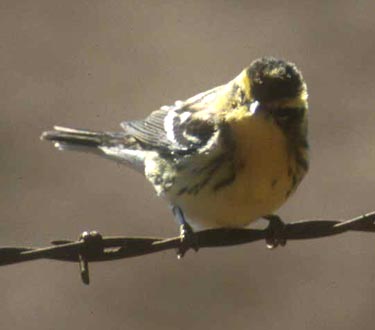 |
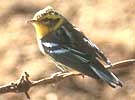 |
These highlights chronicle the year 2002. Created incrementally as new photos were available, the year runs generally "backwards" on this page. The abbreviation "MTY" means "Monterey County" in the text below. Text by Don Roberson. Photos on this page are copyrighted by the photographers to whom they are attributed, and may not be reproduced in any form (including other web sites) without the express consent of the photographer.
 |
 |
| Prairie Warbler (left)
Dendroica discolor 28 Oct 2002 Carmel R. mouth photo © 2002 Bill Hill |
Blackburnian Warbler (above, both photos)
Dendroica fusca 4 Nov 2002 Moonglow Dairy, Moss Landing photos © 2002 Don Roberson |
Late fall 2002 brought a few colorful or unexpected vagrants, but still
the season wound up rather "average" for autumn migration. "Colorful" is
a good term for this Prairie Warbler (left) found by Nancy
McMahon & June Buntin at the Carmel R. mouth — just past the green
pipe — on 26 Oct, and photographed so vividly by Bill Hill (another
view is on Bill's web site). Another colorful vagrant was a male Blackburnian
Warbler at Moonglow Dairy 22 Oct, and lingering into Nov (above).
The finder, Bruce Gerow, initially described it as so bright as to suggest
it might even be an adult instead of our usual vagrant "hatch-year" birds.
Banding studies on the Farallones have shown that well over 90% of vagrants
are young birds making their first flights south, and misorienting in the
process. Most of the vagrants we see in MTY appear to be immatures. The
Blackburnian looks to be an immature male. The facial color is bright yellow-orange,
not the purer orange of adults (even females), and the wing covert pattern
(details of inner greater coverts, see Pyle 1997) rules out an adult male.
The bird seems a better fit for an imm. male, rather than a fall adult
female, because of its blackish eyeline and more contrasting black-and-white
back (see Dunn & Garrett 1997). Both hatch-year birds and adults have
a prebasic molt on the breeding grounds before they migrate, so each age
is equally fresh-plumaged in the fall. The Prairie Warbler appears to be
a rather bright first-fall male. The blackness of the side streaks strongly
suggest male (Pyle 1997), while the grayish feathers in the auriculars
and the white eyering strong suggests this is a bird in first-basic plumage
(Dunn & Garrett 1997; juvenal plumage in warblers is held very briefly
on the breeding grounds only, so — unlike shorebirds, for example — our
vagrant warblers are never juvenal birds). This means that this bird was
born this year, and is making its first flight south.

"Unexpected" is a good term for two other vagrants of western montane
origin. On 27 Oct, R.J. Adams & Monica Davis found a male Williamson's
Sapsucker Sphyrapicus thyroideus working a Monterey Pine in
Del Monte Forest in Pebble Beach (this nice view from below ? showing the
red chin patch ? is a photo by Bill Hill, right). It would delight
observers at that same tree for days afterwards. It represented only the
6th MTY record, all but one of which were males. See two
other images of this sapsucker on Bill Hill's web site.
Another unexpected find was a Green-tailed Towhee Pipilo chlorurus
in a Pacific Grove yard, beginning 21 Oct and continuing through this update.
First spotted by Rita Carratello, she subsequently video-taped it at her
backyard bird feeder (video snap
below left; 25 Oct, © Rita
Carratello). It was also photographed by her husband (below right;
25 Oct © D. Roberson). This is the 20th Green-tailed Towhee in the
county but only 8 have been found in the last 20 years. The last one at
a feeder was in Bruce Gerow's Salinas yard beginning in Oct 1986 where
it stayed into Feb 1987. The most recent Pacific Grove individual was at
a feeder near Esplanade in Dec 1979-Jan 1980.
 |
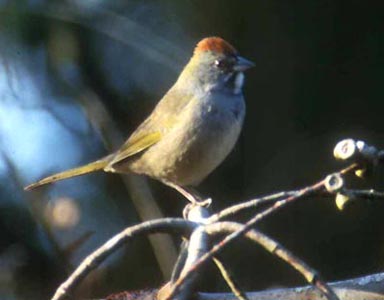 |
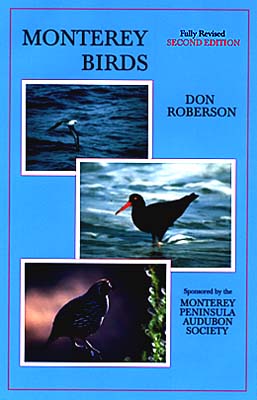 In
mid-November 2002, the 2nd edition of Monterey Birds
(right) is due to be released by the Monterey Peninsula Audubon Society.
The 1st edition was published in 1985; it had 272 pages, including 16 pages
of color photos of birds and habitats. The new edition has 544 pages, including
16 pages of mostly new photos, which means it is twice the length and thickness
of the prior edition.
In
mid-November 2002, the 2nd edition of Monterey Birds
(right) is due to be released by the Monterey Peninsula Audubon Society.
The 1st edition was published in 1985; it had 272 pages, including 16 pages
of color photos of birds and habitats. The new edition has 544 pages, including
16 pages of mostly new photos, which means it is twice the length and thickness
of the prior edition.
In at least one respect, however, the new book will already be outdated by the time it appears. The author states in the Introduction:
"Of the 482 species on the current Monterey County list, I am aware of photographs of 439 species (91%). Only 26 species (5%) on the county list are not supported by specimens or photographs, and all of these have written details on file with North American Birds editors or this author. Three have taped recorded songs or calls on file in addition to multiple written descriptions: Whip-poor-will, Eastern Wood-Pewee, and Kentucky Warbler. For the rarest species, full documentation is on file with the CBRC for at least one record of each Monterey bird if the species was reviewed by them. Two birds have dozens of Monterey County records but apparently have yet to be photographed: Virginia's Warbler and Lapland Longspur..." (emphasis added)While the book was in press, two (2) different Virginia's Warblers were photographed in Monterey County. The Big Sur Ornithology Lab banded one on 25 Sep (lefthand two shots below; © BSOL, used with permission), and Don Roberson found and photographed another along the Big Sur River adjacent to BSOL on 12 Oct (righthand photo below; © D. Roberson). Since the latter bird was unbanded, it was clearly a newly arrived vagrant.
|
|
|
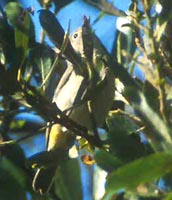 |
Although fall migration was rather routine in 2002, perhaps because there were so many days with bright sunny mornings and clear night skies that encouraged migrants to overfly the county, other highlights of early fall included several Prairie Warblers in early September (Rick Fournier, Blake Matheson et al.); 7 White-faced Ibis on Crespi Pond 12 Sep (S.F. Bailey); a Yellow-green Vireo and Canada Warbler at Big Sur R. mouth 29 Sep (R. Fournier, D. Roberson); 8 Sandhill Cranes flying over Elkhorn Slough NERR 3 Oct (Bryan Largay) and a flock of 13 over Andrew Molera SP on 2 Oct (Lois Goldfrank) that landed briefly at Carmel R. mouth (Bill Hill et al.); Prothonotary Warblers at Pt. Pinos 26 Sep-3 Oct (Rob Fowler et al.) and Big Sur R. mouth 5 Oct (R.F. Tintle et al.); a Lucy's Warbler at Stillwater Cove, Pebble Beach, 6 Oct (Scott & Linda Terrill); and two Blackburnian Warblers at Frog Pond Nature Area in Del Rey Oaks 4-6 Oct (Alex Cruz et al.), that led to a "Patagonia Rest Stop effect" with chasers then turning up Chestnut-sided & Tennessee Warblers, and a 'Baypoll' type (m.ob.).
Crested
Caracara Caracara cheriway
11-13 Aug 2002
Armstrong Ranch, N of Marina
photo © 2002 Bill Hill
Surely the most interesting bird of the summer and early fall was this Crested Caracara present for 3 days along Lapis Road and Del Monte Ave., just north of Marina. The bird could be very obliging (as suggested by Bill Hill's superb photo) or very elusive. [The author of this web page was in Africa at the time, but can confirm that the caracara was "exceptionally elusive" over many hours 16-20 August.] Another (or the same?) caracara appeared just north of Davenport, Santa Cruz Co., in September.
The MTY bird was clearly in molt. Note the very worn and buffy-brown feathers of the lower lesser coverts, median coverts, tertials, and scapulars, and how they contrast with the fresh, black feather coming in on the scapulars, upper lesser coverts. The bird is clearly in wing molt: the three tertials are worn and brown but the innermost secondary is fresh and black, contrasting with the next one that is worn and brown. The back in a mixture of old and new feathers, as is the crown. I am confused about the plumage state, however. Several Internet postings state that this is the molt from Basic I to Definitive Basic (=adult) plumage ? and that may be true ? but the worn brown coverts, scapulars, and remiges appear to me to be worn juvenal feathers (see photos in Wheeler & Clark 1995). If so, Basic I is acquired by partial molt and has many retained juvenal feathers. It is those feathers that are now being replaced through a complete molt. More research is needed, but in any event this is a rather young bird, no more than a year to a year-and-a-quarter old at a maximum. Its age is of importance in evaluating whether it is a wild vagrant or a likely escape.
|
PAGE WITH EXTENSIVE ANALYSIS ON THE QUESTIONS (a) WAS THE MTY BIRD THE SAME AS THE SCZ BIRD and (b) IS IT A WILD BIRD? |
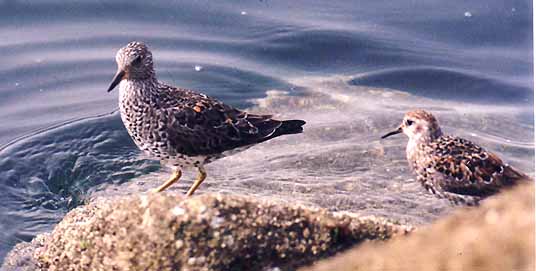 Rock Sandpiper Calidris ptilocnemis
Rock Sandpiper Calidris ptilocnemis
14 Apr 2002
Moss Landing
Photo © 2002 Stan Wulkowicz
Ohio birder and photographer Stan Wulkowicz had a short vacation in the Monterey area in April, and spent some time on the 14th photographing rocky shorebirds on the Moss Landing jetty. He was particularly interested in getting shots of breeding plumaged Surfbird (left-hand bird) but an annoying small shorebird kept walking into the view. He tried to frame the photo without this distraction but two shots did include it. From Alaskan experience Stan recognized the little guy as a Rock Sandpiper (right-hand bird) but didn't realize its status here in Monterey County until several days later (and he didn't see it on another visit to the jetty two days later).
In truth, there are only five previous MTY records of Rock Sandpiper: two winterers, two fall migrants, and one spring migrant. The latter was one in basic plumage along rocky shore from Bird Rock to Spanish Bay, Pebble Beach, 6-16 Mar 1996 (D. Roberson, mob). This April 2002 Rock Sandpiper, in gorgeous alternate (=breeding) plumage, is the first ever to be found here in those colorful feathers.
Last fall on 30 Nov 2001, Lois Goldfrank, Jeff Poklen, and Barry McLaughlin found a basic-plumaged Rock Sandpiper at midday on these same Moss Landing jetties (the first ever for Moss Landing) but that bird was gone by the late afternoon (sad personal experience). Could this spring migrant be their same bird returning, having spent the winter somewhere well to south? Could be. Clearly this April migrant did winter somewhere down south. But where? I don't recall any reported in southern California this winter (correct me if I'm wrong about that). How about Baja California? There are no records for that Mexican peninsula (Howell et al. 2001) but perhaps this one got away?

 The
year started with a bang:
The
year started with a bang:
1-27 Jan 2002
Nelson's Sharp-tailed Sparrows
Ammodramus nelsoni
on Elkhorn Slough
Photos 13 Jan 2002 © 2002 D. Roberson
Two Nelson's Sharp-tailed Sparrows were found on the Moss Landing Christmas Bird Count by Michelle Scott & Bob Davis in Kim Kuska's group, and then seen by his whole party (Lois & Wally Goldfrank, Barry McLaughlin). They were refound thereafter into January at high tides as limited access was sometimes permitted (the dike they frequented at high tide was on private land not usually open to birders).
There are only seven prior MTY records, and these were the first to winter in pickleweed in a tidal environment, as a few more regularly do on San Francisco Bay, and sometimes at Humboldt Bay and Morro Bay.
The other very impressive find on the Moss Landing count was a totally unprecedented 88 Barn Swallows, more than ten times the previous winter high. Perhaps Barn Swallow is the poster bird for global warming?
Literature cited:
Dunn, J.L., and K.L. Garrett. 1997. A Field Guide to Warblers of North America. Houghton Mifflin, Boston, MA.TOPGrinnell, J., and A.H. Miller. 1944. Distribution of the Birds of California. Pacific Coast Avifauna 27.
Howell, S.N.G., R. A. Erickson, R. A. Hamilton, and M. A. Patten 2001. "An annotated checklist of the birds of Baja California and Baja California Sur" in Birds of the Baja California Peninsula: Status, Distribution, and Taxonomy (R. A. Erickson & S.N.G. Howell, eds.). Monographs in Field Ornithol. No. 3, Amer. Birding Assoc., Colorado Springs, CO.
Pyle, P. 1997. Identification Guide to North American Birds. Part I. Slate Creek Press, Bolinas, CA.
Roberson, D. 1985. Monterey Birds. Monterey Pen. Audubon Soc., Carmel, CA.
Wheeler, B. K., and W. S. Clark. 1995. A Photographic Guide to North American Raptors. Academic Press, New York.